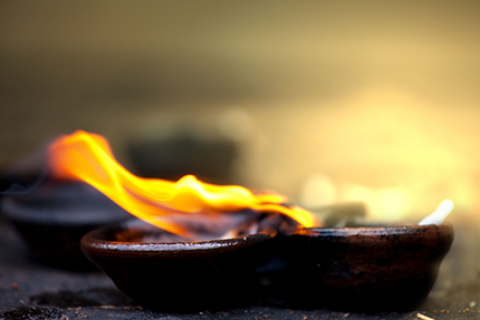
Not too many days ago, on February 1, we celebrated St. Brigid’s Feast Day, which occurs on the ancient festival of Imbolc, the cross-quarter day halfway between Solstice and Equinox.
Though deep in the sleep-time winter, Brigid’s Day falls inside a circle that reverberates with beginnings and awakenings. It comes in the wake of the New Year, which as Rilke said is “full of things that have never been”. Some regard this early February festival as the start of spring, or at least the beginning of the beginning of spring. The ancients saw this day as one of hope; a birthing time for lambs, the understanding that there would be milk, and the possibility of survival until the Earth would fruit again.
In this part of the world, the very most eastern tip of West Virginia, there was a sudden breakthrough of warmth after days of frigid temperatures. The warmth was fleeting, just long enough to awaken anticipation of spring and send folks out to garden, walk, or bike. Along the banks of the Potomac, patches of icy snow remained on the rockfaces rising from the ghost of the old canal; the moss gleamed emerald on the tree trunks and fallen logs. It was good to be out again, taking in the breath of the trees, watching the clouds reflected on the river’s pewter surface, tuning to the hum of stirring beings, the sense of forces on the move.
But rather than resting in such a promising embrace, I can get caught in the lure of fresh starts, the tug of plans to make, projects to make progress on, promises to keep. Any sense of ease melts with the snow. I find myself marching to the beat of my calendar and my lists of important things to do rather than swaying to the slow melody of imagination so resonant in winter’s dreamtime. Yet in dark and turbulent times, listening to the deeper, unhurried music might be precisely what is needed.
Some years ago, and for several years running while I lived at Rolling Ridge, we had a practice of gathering in the Meditation Shelter on New Year’s Eve. In the candlelight and glow of the fire in the woodstove, surrounded by the resting trees, the dark sky and jeweled stars, and the hushed creatures of the place, we too sat quietly, drinking it all in. In the stillness we could feel a deeper reality, sense the presence of the ancestors and all who would visit the place in years to come, and settle into Sacred Mystery. We often shared songs or readings. A favorite was from Clarissa Pinkola Estes, who wrote:
My friends, do not lose heart.. …One of the most calming and powerful actions you can do to intervene in a stormy world is to stand up and show your soul. The light of the soul throws sparks, can send up flares, builds signal fires…causes proper matters to catch fire. To display the lantern of soul in shadowy times like these—to be fierce and to show mercy toward others; both are acts of immense bravery and greatest necessity…Struggling souls catch light from other souls who are fully lit and willing to show it. If you would help to calm the tumult, this is one of the strongest things you can do.
Rolling Ridge has always been a sanctuary where people come to slow down: a place for lantern-bearers to rekindle their flame no matter the season. In times like these, this may be what is needed most. It is why I am drawn to lead retreats there.
Brigid is about the light of the soul, the inner fire of imagination and purpose. It is said that she founded a center of learning and contemplation at her monastery of Kildare and that it contained a flame that it burned for centuries, tended for 19 days by her community, and on the 20th day by Brigid herself.
In her ancient goddess form, Brigid warmed the Earth in spring, spreading her cloak to bring the change of season; she watched over new life and mothers giving birth. In her saintly form, in the Celtic imagination, Brigid was the midwife at the birth of Christ. An old story tells that angels flew Brigid from Ireland to Bethlehem that night. Storyteller Martin Shaw says, “This is a strange thought within strange thoughts, but she may simply have walked into a Connacht hill and found herself in the stable. The deep mind accepts this.”
Brigid is poised between tending the quiet hearth of an inner fire and the deep work of midwifing a holy mystery. On her day precisely between Solstice and Equinox this is a fitting thought, as we seek to keep our lantern alight while contemplating what is ours to do in “shadowy times like these”.
Perhaps a blessing from Brigid to encourage us: Shaw imagines that like any Irish midwife, Brigid would have given a tiny drop of water to the newborn and sang:
A wavelet for your body,
A wavelet for your sounds,
A wavelet for the sweetness of your words.
A wavelet for your fortune,
A wavelet for your goodness,
A wavelet for your health,
A wavelet for your pluck,
A wavelet for your grace,
A wavelet for your generosity.
In the voice of a kindred Irish saint, John O’Donohue, “…may a slow wind work these words of love around you, an invisible cloak to mind your life” on Brigid’s Day and every day in the year to come full of things that have never been.
Lindsay McLaughlin